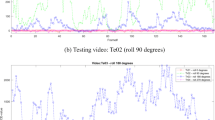Abstract
Nowadays everybody has mobile phone, tablet and other video capturing devices containing high quality cameras. This enable them to recapture the videos from other imitating media such as projectors, the LCD screens etc. Recently, video piracy has become a major criminal enterprise. So, in order to combat this uprising threat of video piracy, content owners and the enforcement agencies such as Motion Pictures Association, have to continuously work hard on video copyright protection laws. This is one of the major reasons why digital forensics has considered recaptured video detection an important problem. This paper presents a simple and an effective mechanism for recaptured video detection which is based upon the noise analysis in the frequency domain. The features adopted are mean, variance, kurtosis and mean square error. These features are calculated on the mean strip extracted from logarithmic magnitude Fourier plot on complete video length.
Access this chapter
Tax calculation will be finalised at checkout
Purchases are for personal use only
Similar content being viewed by others
References
Motion Picture Association of America: Us piracy fact sheet (2005). https://www.mpaa.org/USPiracyFactSheet.pdf
Cao, H., Kot, A.C.: Identification of recaptured photographs on LCD screens. In: 2010 IEEE International Conference on Acoustics Speech and Signal Processing (ICASSP), pp. 1790–1793. IEEE (2010)
Wang, K.: A simple and effective image-statistics-based approach to detecting recaptured images from LCD screens. Digital Invest. 23, 75–87 (2017)
Thongkamwitoon, T., Muammar, H., Dragotti, P.-L.: An image recapture detection algorithm based on learning dictionaries of edge profiles. IEEE Trans. Inf. Forensics Secur. 10(5), 953–968 (2015)
Yang, P., Ni, R., Zhao, Y.: Recapture image forensics based on Laplacian convolutional neural networks. In: Shi, Y.Q., Kim, H.J., Perez-Gonzalez, F., Liu, F. (eds.) IWDW 2016. LNCS, vol. 10082, pp. 119–128. Springer, Cham (2017). https://doi.org/10.1007/978-3-319-53465-7_9
Li, H., Wang, S., Kot, A.C.: Image recapture detection with convolutional and recurrent neural networks. Electron. Imaging 2017(7), 87–91 (2017)
Kumar, G.S., Manikanta, G., Srinivas, B.: A novel framework for video content infringement detection and prevention. In: 2013 International Conference on Advances in Computing, Communications and Informatics (ICACCI), pp. 424–429. IEEE (2013)
Zhang, Y., Zhang, Y.: Research on video copyright protection system. In: 2012 2nd International Conference on Consumer Electronics, Communications and Networks (CECNet), pp. 1277–1281. IEEE (2012)
Nakashima, Y., Tachibana, R., Babaguchi, N.: Watermarked movie soundtrack finds the position of the camcorder in a theater. IEEE Trans. Multimedia 11(3), 443–454 (2009)
Wang, W., Farid, H.: Detecting re-projected video. In: Solanki, K., Sullivan, K., Madhow, U. (eds.) IH 2008. LNCS, vol. 5284, pp. 72–86. Springer, Heidelberg (2008). https://doi.org/10.1007/978-3-540-88961-8_6
Zhai, G., Wu, X.: Defeating camcorder piracy by temporal psychovisual modulation. J. Disp. Technol. 10(9), 754–757 (2014)
Roopalakshmi, R.: A brand new application of visual-audio fingerprints: estimating the position of the pirate in a theater-a case study. Image Vis. Comput. 76, 48–63 (2018)
Author information
Authors and Affiliations
Corresponding author
Editor information
Editors and Affiliations
Rights and permissions
Copyright information
© 2020 Springer Nature Singapore Pte Ltd.
About this paper
Cite this paper
Mehta, P., Maheshkar, S., Maheshkar, V. (2020). An Effective Video Bootleg Detection Algorithm Based on Noise Analysis in Frequency Domain. In: Nain, N., Vipparthi, S., Raman, B. (eds) Computer Vision and Image Processing. CVIP 2019. Communications in Computer and Information Science, vol 1147. Springer, Singapore. https://doi.org/10.1007/978-981-15-4015-8_20
Download citation
DOI: https://doi.org/10.1007/978-981-15-4015-8_20
Published:
Publisher Name: Springer, Singapore
Print ISBN: 978-981-15-4014-1
Online ISBN: 978-981-15-4015-8
eBook Packages: Computer ScienceComputer Science (R0)




